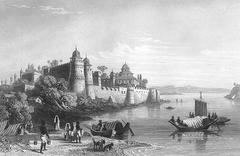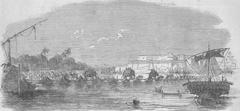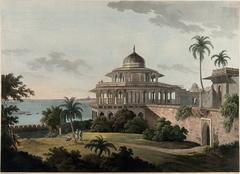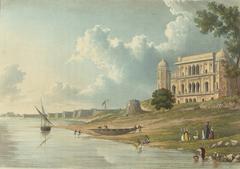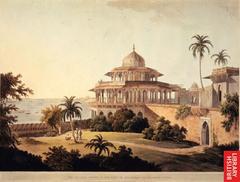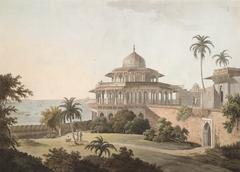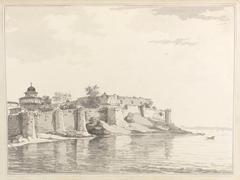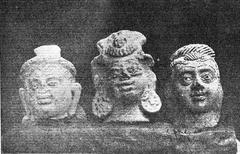
Comprehensive Guide to Visiting Allahabad Fort, Prayagraj, India
Date: 17/07/2024
Introduction
The Allahabad Fort in Prayagraj, India, stands as a magnificent testament to the region’s rich historical and cultural tapestry. Constructed by Emperor Akbar in 1583, this fort is strategically positioned at the confluence of the Ganges, Yamuna, and the mythical Saraswati rivers—collectively known as the Triveni Sangam. This location is not just of architectural interest but also of immense religious significance. The fort’s construction aimed to consolidate Mughal power in the region, serving both as a defensive stronghold and an administrative center. Today, the Allahabad Fort is a unique blend of Islamic and Hindu architectural styles, featuring notable structures like the Ashoka Pillar and the Patalpuri Temple, attracting tourists and devotees alike. Our comprehensive guide aims to provide practical information, from visiting hours and ticket prices to travel tips and historical insights, ensuring that your visit to this iconic monument is both enriching and enjoyable (Britannica, India.com).
Table of Contents
- Introduction
- Construction and Early History
- Historical Significance and Visiting Hours
- Architectural Marvel
- Role in Mughal Administration
- British Era and Beyond
- Cultural and Religious Significance
- Visitor Tips and Practical Information
- Emergency Contacts
- Frequently Asked Questions (FAQ)
- Nearby Attractions
- Conclusion
- References
Construction and Early History
Commissioned by Emperor Akbar, the fort was constructed at the Triveni Sangam to consolidate Mughal control over the region and protect the empire from potential invasions (Cultural India).
Historical Significance and Visiting Hours
Allahabad Fort, located in Prayagraj, India, stands as a testament to the architectural prowess and strategic acumen of the Mughal Empire. Constructed in 1583 by Emperor Akbar, the fort was strategically positioned at the confluence of the Ganges, Yamuna, and the mythical Saraswati rivers (Britannica). Visiting hours can vary, especially since the fort is under military control. Generally, the fort is open to visitors during daylight hours, but it is best to check with local authorities for the most accurate and current visiting times.
Architectural Marvel
The fort is renowned for its robust construction and intricate design, blending Islamic and Hindu architectural styles. The fort’s walls, made of red sandstone, are a striking feature, standing tall and imposing. The fort encompasses several notable structures, including:
The Ashoka Pillar
Dating back to 232 BCE, this significant historical artifact is inscribed with edicts from Emperor Ashoka’s reign (India.com).
Saraswati Koop
Believed to be the source of the mythical Saraswati River, this site holds immense religious significance (Kumbh Mela).
Patalpuri Temple and Akshaya Vat
The Patalpuri Temple is an ancient underground temple dedicated to various Hindu deities. Adjacent to the temple is the Akshaya Vat, or the immortal banyan tree, which holds a significant place in Hindu mythology (Hindustan Times).
Role in Mughal Administration
Under Akbar’s rule, Allahabad Fort served as a key administrative center. It housed a garrison and served as a treasury, playing a crucial role in the Mughal Empire’s governance (Cultural India).
British Era and Beyond
During the British colonial period, the fort continued to hold military significance. It was used as a garrison and played a role in the suppression of the Indian Rebellion of 1857. Post-independence, the fort was handed over to the Indian Army and remains under military control, with limited access to the public (Lonely Planet).
Cultural and Religious Significance
The fort holds immense cultural and religious significance, attracting pilgrims, especially during the Kumbh Mela (Kumbh Mela).
Visitor Tips and Practical Information
Access and Entry
Given that Allahabad Fort is under the control of the Indian Army, public access is restricted. However, certain areas, such as the Ashoka Pillar and the Patalpuri Temple, are open to visitors during specific times. It is advisable to check with local authorities or tour operators for the latest access information, visiting hours, and ticket prices (Tripadvisor).
Best Time to Visit
The best time to visit Allahabad Fort is during the winter months, from October to March, when the weather is pleasant. Visiting during the Kumbh Mela, which occurs every 12 years, offers a unique experience, as the fort and the surrounding areas come alive with religious fervor and cultural activities (Kumbh Mela).
Guided Tours
To fully appreciate the historical and cultural significance of Allahabad Fort, it is recommended to take a guided tour. Knowledgeable guides can provide in-depth information about the fort’s history, architecture, and religious importance, enhancing the visitor experience. Several local tour operators offer guided tours, which can be booked in advance (Viator).
Dress Code and Footwear
Visitors are advised to wear comfortable clothing and footwear suitable for walking. Lightweight, breathable fabrics are recommended, especially during the warmer months. Additionally, wearing a hat and sunglasses can help protect against the sun.
Photography and Etiquette
Photography is allowed in certain areas of the fort, but it is essential to respect the rules and regulations set by the authorities. Visitors should also be mindful of the fort’s religious significance and maintain decorum, especially in areas of worship. It is advisable to dress modestly and follow the guidelines provided by the tour guides or local authorities (Lonely Planet).
Safety and Security
Allahabad Fort is generally safe for tourists, but it is always wise to take standard precautions. Keep your belongings secure and be aware of your surroundings. Avoid carrying large amounts of cash and valuables. The fort is patrolled by security personnel, and there are CCTV cameras installed at various points for added security.
Accessibility
The fort is partially accessible to visitors with disabilities. While the main entrance and some areas are wheelchair-friendly, certain sections, such as the underground Patalpuri Temple and the Ashoka Pillar, may be challenging to access. It is advisable to check with the fort authorities for specific accessibility information and assistance.
Food and Refreshments
There are no food stalls or restaurants within the fort premises, so it is advisable to carry water and light snacks. However, several eateries and cafes are located nearby, offering a variety of local and international cuisines.
Souvenirs and Shopping
For those interested in purchasing souvenirs, there are several shops and markets near the fort. These include Chowk Market and Civil Lines, where visitors can find traditional handicrafts, clothing, jewelry, and other souvenirs.
Cultural Etiquette
When visiting Allahabad Fort, it is important to respect local customs and traditions. Dress modestly, especially when visiting religious sites within the fort, such as the Patalpuri Temple. Remove your shoes before entering any temple or sacred area. Additionally, be mindful of local sensitivities and avoid loud or disruptive behavior.
Emergency Contacts
In case of emergencies, the following contact numbers may be useful:
- Local Police: 100
- Ambulance: 102
- Tourist Helpline: 1363 (available in multiple languages)
Frequently Asked Questions (FAQ)
What are the visiting hours for Allahabad Fort?
The fort is open daily from 7:00 AM to 6:00 PM.
How to buy tickets for Allahabad Fort?
Tickets can typically be purchased on-site, but checking with local tour operators or official websites can provide information on advance booking options.
What are the best nearby attractions in Prayagraj?
Prayagraj is home to several historical and cultural sites, including the Triveni Sangam, Anand Bhavan, and the Allahabad Museum. Exploring these nearby attractions can enrich your visit to Allahabad Fort.
Nearby Attractions
- Triveni Sangam: The confluence of the Ganges, Yamuna, and the mythical Saraswati rivers, located about 4 km from the fort. It is a significant pilgrimage site and offers boat rides for visitors.
- Anand Bhavan: The ancestral home of the Nehru family, now a museum showcasing the life and times of India’s first Prime Minister, Jawaharlal Nehru. It is located approximately 5 km from the fort.
- Khusro Bagh: A historical garden and burial complex of the Mughal prince Khusro Mirza, situated around 6 km from the fort. It features beautiful Mughal architecture and well-maintained gardens.
Conclusion
Allahabad Fort, with its rich history, architectural grandeur, and cultural significance, offers a unique glimpse into India’s past. While access may be limited, the fort’s historical and religious landmarks make it a must-visit for history enthusiasts and spiritual seekers alike. By planning ahead and respecting the site’s significance, visitors can have a memorable and enriching experience at this iconic monument. For more updates, follow us on social media or download our mobile app Audiala (Lonely Planet, Kumbh Mela).
References
- Discover the Rich History and Visiting Tips for Allahabad Fort in Prayagraj (Britannica)
- Allahabad Fort - Visiting Hours, Tickets, and Historical Significance in Prayagraj (India.com)
- Complete Visitor Guide to Allahabad Fort, Prayagraj - History, Tickets, and Tips (Kumbh Mela)
- Allahabad Fort - Visiting Hours, Tickets, and Historical Significance in Prayagraj (Lonely Planet)


